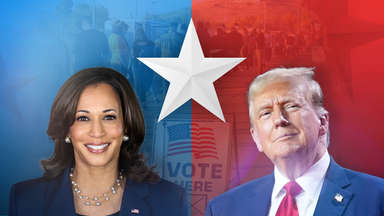How does the US election work? A really simple guide to put you in the know
Here’s what you need to know as election day looms – from who the candidates are to how votes are cast and an explanation of how the Electoral College works. Plus: why is it always on a Tuesday?

Voters across 50 US states are preparing to elect their new president.
It’s been another presidential race full of dramatic twists and turns, with just hours to go before election day on Tuesday.
The US is guaranteed a new president, but understanding the way it happens can be challenging.
This guide will explain how it all works; from who is in the running to how votes are cast and what the Electoral College is. Plus, why is election day always on a Tuesday?
Who is running?
There are five candidates in the running for the presidency, but it’s incredibly rare that any parties outside of the Democrats and Republicans are competitive in elections.
Kamala Harris – Democrat
The current vice president was endorsed by President Joe Biden shortly after he withdrew from the race in July.
It came after questions were raised over his fitness for office and rumours had begun circulating that his campaign team was assessing whether Ms Harris could take over.
She was officially declared the Democratic Party candidate in early August and immediately launched a campaign, often criticising opponent Donald Trump on the trail.
At the Democratic National Convention, she attacked the former president by framing his time in the White House as “chaos and calamity” and insisting: “We are not going back!”
She warned voters about the prospect of a second Trump term, describing him as self-serving, criticising his recent fraud charges, and warning about his immunity from criminal prosecution by posing the question: “Just imagine Donald Trump with no guardrails.”
Ms Harris has been serving as vice president since Mr Biden was elected in the 2020 election.
Donald Trump – Republican
Mr Trump is running for a third time having won his first election in 2016 and lost four years later to Mr Biden.
He has had a whirlwind of a campaign so far.
The former businessman outperformed a struggling Mr Biden in an extraordinary debate in June, survived an assassination attempt at a rally in July and had his rival drop out of the race shortly after.
Analysts believed Mr Trump was pulling away from the Democrats during the summer, but the Democrats’ switch to Ms Harris took attention away from the billionaire and appears to have unified the party.
He, like Ms Harris, has launched personal attacks on his opponent, regularly calling her “Comrade Kamala Harris”, accusing her of “fake Indian heritage” and being “weak and ineffective”.
He recently criticised Ms Harris for her government’s record on crime, the economy and illegal immigration – even suggesting she would take America “into a nuclear World War Three”.
Jill Stein – Green Party
Ms Stein is no stranger to long-shot presidency bids, having also run in 2012 and 2016.
Announcing her candidacy this time around, the left-wing doctor said the current political system is “broken”.
Some Democrats believe that her presidential run in 2016 siphoned votes away from Hillary Clinton and helped Mr Trump win, particularly in states such as Wisconsin – and some have expressed concerns the same could happen again this time.
Cornel West – Independent
The activist and scholar announced in October that he was ending his bid for the presidency under the Green Party banner and was instead running as an independent.
While he faces long odds in his quest to become the first candidate not affiliated with a major political party to win the presidency, Democrats, much like with Ms Stein, are quietly concerned he could make a significant impact on the 2024 contest by winning even a small portion of the vote in key states that would otherwise go to Ms Harris.
Chase Oliver – Libertarian Party
Mr Oliver, an activist from Atlanta who previously ran for the US Senate and House from Georgia, was nominated as the Libertarian candidate in May.
The party prioritises small government and individual freedoms, with a mix of policy positions that could be seen as liberal, conservative or neither.
His campaign website calls for major cuts to the federal budget with an eye toward balancing the budget, the abolition of the death penalty, and the closure of all overseas military bases as well as ending of military support to Israel and Ukraine.
What do Democrats and Republicans stand for?
The two dominant US parties are on opposite sides of the political spectrum.
The Democrats, represented by Ms Harris, are more liberal, meaning left-wing. Many of the party’s policies focus broadly on social issues and civil rights like abortion.
Ms Harris’s policy guide states she is “fighting for a new way forward that protects our fundamental freedoms, strengthens our democracy, and ensures every person has the opportunity to not just get by, but to get ahead”.
Republicans are the conservative US party, and focus on things like tougher immigration and abortion laws, lowering taxes and more lax gun laws.
Mr Trump’s top core promises on his campaign website are to “seal the border and stop the migrant invasion”, “carry out the largest deportation operation in American history” and to “end inflation, and make America affordable again”.
What are Americans voting for besides president?
They will also be voting for a vice president, but that vote is tied in with the one for president, meaning a vote for Mr Trump is a vote for his running mate JD Vance and a vote for Ms Harris is also one for her running mate Tim Walz.
Voters will also elect new members of Congress, the legislative branch of the US government which is made up of two parts: the House of Representatives and the Senate.
Each state has two Senators and at least one Representative.
All 435 seats in the House of Representatives are up for election, while 33 Senate seats will also be decided in November.
There can also be voting sections relevant to local politicians or individual state laws. If voters choose to leave some sections blank, their vote in other sections still count.
Who can vote?
All US citizens aged 18 and over can vote in the election.
There are exceptions in some states, where some people cannot vote after being convicted of a felony (a serious crime punishable by more than a year in prison) or if they are currently serving time in prison for a lesser offence.
Some people who have a mental disability may not be able to vote in some states.
What is the Electoral College?
Americans don’t actually vote directly for who they want to be president and vice president.
Instead, they vote for “electors” – members of the Electoral College – who back their choice of candidate for those roles.
There are a total of 538 electors across the US – one for each member of Congress, plus three additional voters from the District of Columbia.
Each of the 50 US states has a number of electors depending on its population.
California, which has a population of nearly 40 million, has 54 votes in the Electoral College – while North Dakota, home to about 762,000 people, has just three votes.
Most states operate a winner-takes-all system, so if a candidate wins the most votes in a state, they get all the Electoral College votes.
Sticking with California as an example, the state’s population of 40 million cast about 17.1 million votes in the 2020 election; 11,110,250 for Mr Biden and 6,006,429 for Mr Trump – meaning their electoral votes went to Mr Biden.
Just two states, Maine and Nebraska – which have four and five electors respectively – divide their electoral votes according to how many public votes each candidate receives. The first two electors go to the overall winner of the public’s votes and then the rest are split proportionally.
Read more:
‘There’ll be a revolution’: Deep divisions ahead of election
How one ‘must-win’ state could shape the US election
Trump threatens to imprison Mark Zuckerburg if he ‘does anything illegal’
We’ll use Nebraska’s 2020 results to explain this one: residents in the state gave 556,846 votes to Mr Trump and 374,583 to Mr Biden.
Nebraska has five electoral votes, so in most other states, Mr Trump would have got all five. But because Nebraska divides them, four electoral votes were given to Mr Trump and one to Mr Biden.
The first candidate to 270 Electoral College votes wins the presidency.
In the last election, Mr Biden won by 306 votes to Mr Trump’s 232.
If no candidate gets an absolute majority then the House of Representatives elects the president through something called a contingent election – wherein Representatives vote for the president based on the three top candidates. But this has only happened three times in the entire history of the US – and it’s been more than 200 years since the last time.
What are swing states?
It’s a term you’ll have been hearing a lot.
Populations in most states have a predictable political bias – Wyoming, for instance, has voted exclusively Republican since 1968 and Massachusetts has voted Democrats in all but four elections since 1932.
But swing states, also known as battleground or toss-up states, hold disproportionate sway in presidential elections because they switch between voting Republican and Democrat.
Millions of dollars are poured into campaigning in swing states as winning the additional college votes can be crucial.
In 2024, the critical states are likely to include Arizona, Georgia, Michigan, Nevada, Pennsylvania and Wisconsin.
Winning the popular vote doesn’t mean you win the election
Because of the way the Electoral College system works, the candidate who is most popular with voters may not wind up being elected president.
This happened in 2016 when Hillary Clinton gained almost three million more votes than Mr Trump – but he won the presidency with 304 Electoral College votes to her 227.
In 2000, George W Bush won with 271 Electoral College votes, but Democrat candidate Al Gore won the popular vote by more than half a million.
When do the polls close – and when is the winner announced?
Polls begin to close on the East Coast at 7pm local time, or midnight UK time.
The rest trickle in overnight until polls close on the West Coast at about 11pm EST and 4am GMT.
Historically, at around this point, a winner is declared, but there may not be a final result for days – or even weeks – this time around.
Vote counting generally is more complicated in the US than in the UK, partially due to the sheer size of the country; the varying time differences alone make for a longer process.
But in the 2020 presidential election, it took four days for Mr Biden to be called the winner, with many putting it down to the fact that more people voted by post than usual due to the COVID-19 pandemic.
Election officials are optimistic that the 2024 vote count will be smoother without the many challenges the pandemic posed to officials in 2020, according to NBC News.
But as of Monday, more than 77 million Americans had already cast their votes in the US election, according to the University of Florida’s Election Lab – 42,195,018 returned in person and 35,173,674 by mail.
That total is already almost half the 160 million votes returned in 2020, the highest turnout the US has seen in more than a century.
A high number of votes to count, especially in a handful of key battleground states, could keep Americans waiting well beyond election day yet again.
What if it’s incredibly close?
If it’s as close as polls are suggesting it may be, this election may end up being known as the “litigation election”, Sky News commentator Adam Boulton says.
He warns there is a risk of uncertainty and unrest if there is not a clear result on US election night or shortly afterwards, saying if the outcome is disputed, legal fights and a bumpy transfer of power can be expected.
“If Trump looks like losing narrowly because one or two swing states go against him, he will do what he can to spread distrust, to delay Harris being declared winner and, ultimately perhaps, to overturn his defeat at the polls,” he adds.
“That is why insiders are calling this the ‘litigation election’. Both sides are assembling massive legal teams ready to fight it out.”
In theory, with an even number of US states, it could even end up being a tie. If that happens, the decision for the next president and vice president is taken out of the public’s hands.
If no one gets the 270 votes needed, the president would be chosen by the House of Representatives in what’s known as a contingent election.
You can find out more about that here.
When does the winner take office?
While there will be a projected winner this week, the actual Electoral College vote happens in December when the electors meet in their states.
Until the electoral votes are officially cast, the president hasn’t actually been elected.
It’s seen as more of a formality, as electors respect their state’s voters and the conclusion they came to in November the vast majority of the time. In most states, there are laws in place which forbid electoral voters from straying from their state’s favoured winner.
However, there have been instances where so-called “faithless electors” go against their state’s preferred vote, though it has never changed the outcome of an election.
In early January, Congress meets in a joint session to count the electoral votes. The vice president – in this case, Ms Harris – presides over the count and announces who has been elected as the president and vice president.
The winners are referred to as the president-elect and vice president-elect up until their inauguration later in January.
It’s at the inauguration that the pair are sworn into office and enter the White House to kick off their four-year term.
How does voting work?
Similarly to the UK system, people in the US vote on ballot papers, and most do so in person at their local voting station.
There are three ways of filling out the ballots:
• Hand-marked paper ballots – most people vote by hand, according to data from Verified Voting, an organisation that tracks voting technology.
• Ballot marking device – these are machines that allow voters to make their selections electronically and also produce a paper record. About a quarter of people vote with these machines, Verified Voting says.
• Electronic machines – About 7% of voters live in jurisdictions that use direct recording electronic (DRE) machines, computers that store votes in memory, typically without a paper trail.
In most states voting by post is permitted, or people can drop off their ballot early at their local election office.
This is mainly for people who might struggle to get to the polling station or for US citizens who are abroad or serving in the army.
Most states also allow early in-person voting for those who may struggle to get to a polling station on the day but don’t want to vote by post or drop their ballot off.
What’s on the ballot?
Ballots can look different from state to state, but there’s always the presidential section, where the voter marks which president and vice president they want to win, and the sections where you vote for Senators and Representatives.
You make your choices by marking the box next to whichever candidate you want to vote for.
How are votes counted?
In most states, they are counted by electronic scanner, though they are occasionally counted by hand.
Why is election day always a Tuesday?
It’s always the first Tuesday after the first Monday in November and has been that way since 1845.
According to History.com, it’s because most citizens worked as farmers and lived far from their polling place in the 1800s, with people often travelling for at least a day to vote.
It meant lawmakers needed to allow a two-day window for election day. Weekends were impractical because most people attended church and Wednesday was market day for farmers, History.com says, making Tuesday the most viable option.
Holding it in the month of November is farming related too, it says, because spring and summer elections were thought to interfere with the planting season and late summer and early autumn ones overlapped with the harvest.
November was seen as the middle ground between farming disruptions and the cold winters, when travelling to polling stations may have proved challenging.
Where can I keep up with election day?
There will be live coverage on Sky News throughout election night, led by chief presenter Mark Austin, world news presenter Yalda Hakim and US correspondent Mark Stone.
Fellow correspondents James Matthews and Martha Kelner will be reporting on the ground in the candidates’ home states of Florida and California as the results come in.
As it becomes clearer who will become the next president, chief presenter Anna Botting and presenter Gillian Joseph will join Austin, Stone and Hakim for both the build-up and aftermath of the election.
Be the first to get Breaking News
Install the Sky News app for free


On the night, Sky News will have access to the most comprehensive exit poll and vote-counting results from every state, county and demographic across America through its US-partner network NBC.
You can find out more about Sky News’ coverage here.


